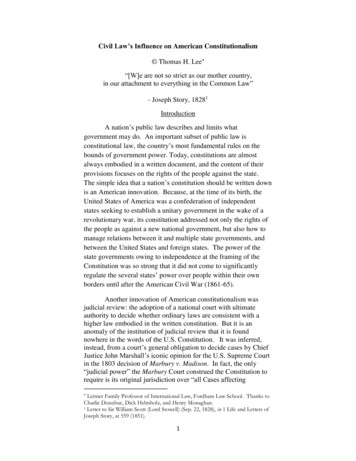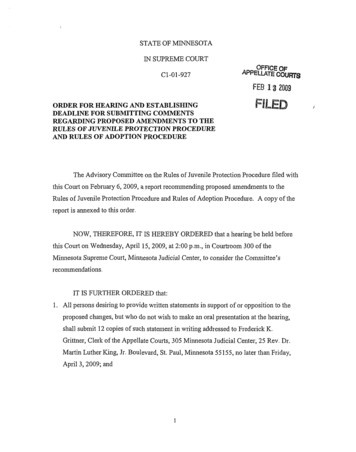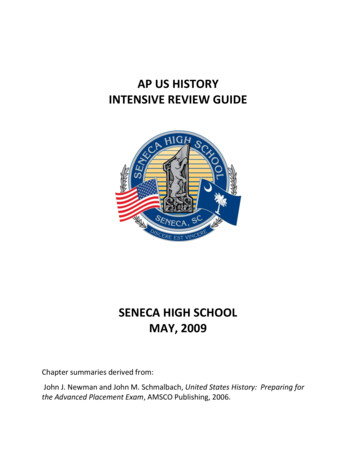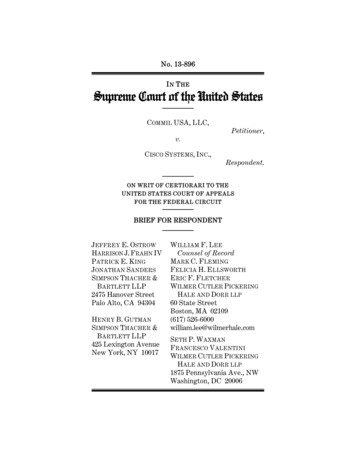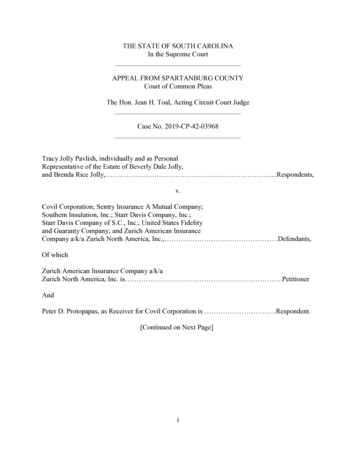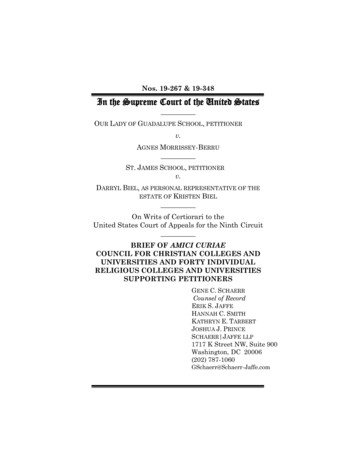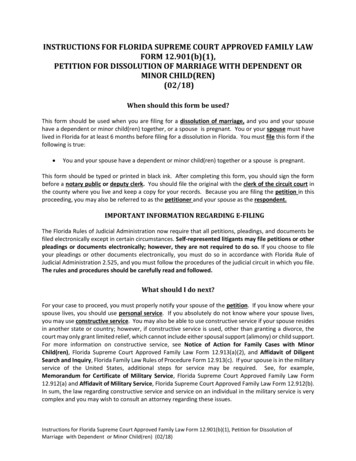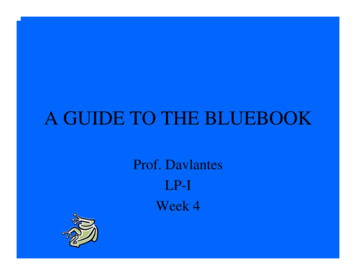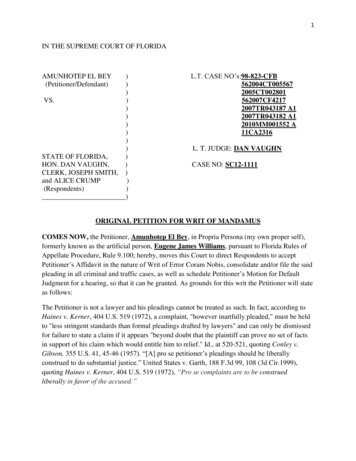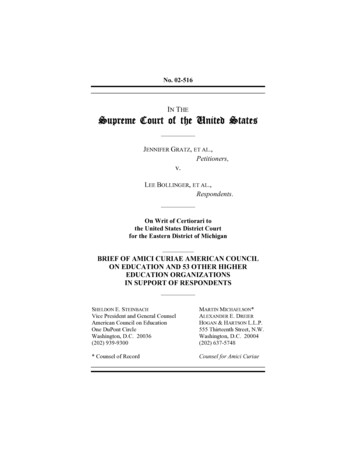
Transcription
No. 02-516IN THESupreme Court of the United StatesJENNIFER GRATZ, ET AL.,Petitioners,v.LEE BOLLINGER, ET AL.,Respondents.On Writ of Certiorari tothe United States District Courtfor the Eastern District of MichiganBRIEF OF AMICI CURIAE AMERICAN COUNCILON EDUCATION AND 53 OTHER HIGHEREDUCATION ORGANIZATIONSIN SUPPORT OF RESPONDENTSSHELDON E. STEINBACHVice President and General CounselAmerican Council on EducationOne DuPont CircleWashington, D.C. 20036(202) 939-9300MARTIN MICHAELSON*ALEXANDER E. DREIERHOGAN & HARTSON L.L.P.555 Thirteenth Street, N.W.Washington, D.C. 20004(202) 637-5748* Counsel of RecordCounsel for Amici Curiae
AMICI ON THIS BRIEFAmerican Council on EducationAmerican Anthropological AssociationAmerican Association of Colleges for Teacher EducationAmerican Association of Colleges of NursingAmerican Association of Collegiate Registrars and Admissions OfficersAmerican Association of Community CollegesAmerican Association of State Colleges and UniversitiesAmerican Association of University ProfessorsAmerican Association of University WomenAmerican College Personnel AssociationAmerican Dental Education AssociationAssociation of Academic Health CentersAssociation of American Law SchoolsAssociation of American UniversitiesAssociation of Baccalaureate Social Work Program Directors, Inc.Association of Catholic Colleges and UniversitiesAssociation of Chiropractic CollegesAssociation of Community College TrusteesAssociation of Governing Boards of Universities and CollegesAssociation of Independent Colleges and Universities in MassachusettsAssociation of Independent Colleges and Universities of MichiganAssociation of Independent Colleges and Universities of PennsylvaniaAssociation of Independent Colleges of Art and DesignAssociation of Jesuit Colleges and UniversitiesCollege and University Professional Association for Human ResourcesConnecticut Conference of Independent CollegesCouncil for Advancement and Support of EducationCouncil for Christian Colleges and UniversitiesCouncil for Higher Education AccreditationCouncil for Higher Education of the United Church of ChristCouncil for Opportunity in EducationCouncil of Graduate SchoolsCouncil of Independent CollegesCouncil on Social Work EducationEducational Testing ServiceEducauseGroup for the Advancement of Doctoral Education in Social WorkHispanic Association of Colleges and UniversitiesMennonite Education AgencyNational Association for College Admission CounselingNational Association for Equal Opportunity in Higher EducationNational Association of College and University Business OfficersNational Association of Deans and Directors of Schools of Social WorkNational Association of Independent Colleges and UniversitiesNational Association of Social WorkersNational Association of State Universities and Land-Grant CollegesNational Association of Student Financial Aid AdministratorsNational Association of Student Personnel AdministratorsNational Collegiate Athletic AssociationSociety for College and University PlanningUnited Negro College FundUnited States Student AssociationUniversity Continuing Education AssociationWashington Association of Independent Colleges and Universities
TABLE OF CONTENTSPageTABLE OF AUTHORITIES . iiiSTATEMENT OF THE INTEREST OF AMICI. 1SUMMARY OF ARGUMENT . 2ARGUMENT. 4I.THE QUALITY OF AMERICAN HIGHEREDUCATION IS ROOTED IN GOVERNMENTALFORBEARANCE. 4II. LEADERS OF ALL TYPES OF COLLEGES ANDUNIVERSITIES HOLD THAT RACIAL ANDETHNIC STUDENT DIVERSITY ISEDUCATIONALLY VALUABLE. 13III. STUDENT DIVERSITY IS A COMPELLINGGOVERNMENTAL INTEREST. 15A. Educators’ Belief That Student DiversityAdvances Higher Education’s Mission HasAmple Basis. 151. Diversity is essential to basic purposes ofhigher education. . 15a. Diversity fosters the examined life. . 15b. Diversity prepares students forcitizenship. . 18c. Diversity enhances education foreconomic and scientific progress. 19(i)
iiTABLE OF CONTENTS—ContinuedPaged. By breaking down barriers, diversityadvances a chief purpose of highereducation. 212. Racial and ethnic diversity is valuable in astudent body because salient to the world inwhich we live. . 253. Research confirms that racial and ethnicdiversity improves educational outcomes. . 26B. Government Has a Compelling Interest in theQuality of Higher Education. 29CONCLUSION. 31ADDENDUM
TABLE OF AUTHORITIESPageCASES:Board of Curators of Univ. of Mo. v. Horowitz, 435U.S. 78 (1978) .7, 8Board of Educ., Island Trees Union Free Sch. Dist.No. 26 v. Pico, 457 U.S. 853 (1982) .18DeRolph v. State, 677 N.E.2d 733 (Ohio), clarified,678 N.E.2d 886 (Ohio 1997) .18Ewing v. Board of Regents of Univ. of Mich., 742F.2d 913 (6th Cir. 1984), rev’d, 474 U.S. 214(1985) .7Hamilton v. Regents of Univ. of Cal., 293 U.S. 245(1945) .6, 9Keyishian v. Board of Regents of Univ. of N.Y., 385U.S. 589 (1967) .12M’Culloch v. Maryland, 17 U.S. (4 Wheat.) 316(1819) .6Mueller v. Allen, 463 U.S. 388 (1983) .18Plyler v. Doe, 457 U.S. 202 (1982) .21Regents of Univ. of Cal. v. Bakke, 438 U.S. 265(1978) .7Regents of Univ. of Mich. v. Ewing, 474 U.S. 214(1985) . 7, 8, 11Sweatt v. Painter, 339 U.S. 629 (1950).iii12
ivTABLE OF AUTHORITIES—ContinuedPageCASES:Sweezy v. New Hampshire, 354 U.S. 234 (1957) .7, 12Taylor v. Columbian Univ., 226 U.S. 126 (1912) .6Trustees of Dartmouth College v. Woodward, 17U.S. (4 Wheat) 518 (1819) .2, 5University v. People, 99 U.S. 309 (1878).6University of Pa. v. EEOC, 493 U.S. 182 (1990).12Washington Univ. v. Rouse, 75 U.S. (8 Wall.) 439(1869) .6CONSTITUTION:U.S. Const. amend. xiv § 1 .6STATUTES:20 U.S.C. §§ 1001-1002.11Civil Rights Act of 1964, 42 U.S.C. § 2000 et seq. .23Education Amendments of 1972, Pub. L. No. 92318, 86 Stat. 235.10Education Amendments of 1978, Pub. L. No. 95561, 92 Stat. 2143.10Education Amendments of 1984, Pub. L. No. 98511, 98 Stat. 2366.10
vTABLE OF AUTHORITIES—ContinuedPageSTATUTES:Higher Education Act of 1965, Pub. L, No. 89-329,79 Stat. 1219.10Higher Education Amendments of 1986, Pub. L.No. 99-498, 100 Stat. 1268.10Higher Education Amendments of 1992, Pub. L.No. 102-325, 106 Stat. 448.10Higher Education Amendments of 1998, Pub. L.105-244, 112 Stat. 1581 .10Job Training Partnership Act, 29 U.S.C. § 1501 etseq.19Morrill Land-Grant Act, 12 Stat. 503 (1862) (codified as amended at 7 U.S.C. §§ 301-305, 307308). 2, 9, 19Servicemen’s Readjustment Act of 1944, 58 Stat.288 .2, 9Workforce Investment Act of 1998, 29 U.S.C. §2801 et seq.19REGULATIONS and RULES:34 C.F.R. § 100.3(b)(6)(ii) .1144 Fed. Reg. 58,509 (Oct. 10, 1979) .1156 Fed. Reg. 64,548 (Dec. 10, 1991) .11
viTABLE OF AUTHORITIES—Continued59 Fed. Reg. 8756 (Feb. 23, 1994).Page11LEGISLATIVE MATERIALS:H.R. Rep. No. 78-1418 (1944) .10OTHER AUTHORITIES:Henry Adams, The Education of Henry Adams(1927) .23Jonathan R. Alger, The Educational Value ofDiversity, 83 Academe 20 (Jan.-Feb. 1997).25Philip G. Altbach, An International AcademicCrisis? The American Professoriate in Comparative Perspective, 126 Daedalus 315 (1997) .4American Ass’n of Community Colleges, Statementon Inclusion (Apr. 12, 1997) .14American Ass’n of State Colleges and Univs.,Access, Inclusion and Equity: Imperatives forAmerica’s Campuses (1997) .14American Ass’n of State Colleges and Univs.,Policy on Racism and Campus Diversity (Mar.1989).14American Ass’n of Univ. Professors, AffirmativeAction, 83 Academe 38 (July-Aug. 1997).14
viiTABLE OF AUTHORITIES—ContinuedPageOTHER AUTHORITIES:American Council on Educ. & American Ass’n ofUniv. Professors, Does Diversity Make a Difference? Three Research Studies on Diversity inCollege Classrooms (2000) .28American Council on Educ., Making the Case forAffirmative Action in Higher Education: WhatYou Can Do to Safeguard Affirmative Action onCampus and in Your Community (March 1999) .13, 14American Council on Educ. Bd. of Directors,Statement on Affirmative Action and Diversity(May 25, 1995) .14Association of Am. Univs., On the Importance ofDiversity in University Admissions, N.Y. Times,Apr. 24, 1997.14Alexander W. Astin, Diversity and Multiculturalismon the Campus: How are Students Affected?, 25Change 44 (Mar./Apr. 1993) .26Alexander W. Astin, What Matters in College?(1993) .26David J. Barron, The Promise of Cooley’s City:Traces of Local Constitutionalism, 147 U. Pa. L.Rev. 487 (1999).18Derek Bok, Higher Learning (1986).5
viiiTABLE OF AUTHORITIES—ContinuedPageOTHER AUTHORITIES:Robert H. Bork, The Limits of GovernmentalRegulation, in The University and the State:What Role for Government in Higher Education? (S. Hook et al. eds., 1978).4William G. Bowen & Derek Bok, The Shape of theRiver (1998).20John S. Brubacher, On the Philosophy of HigherEducation (1982).19John S. Brubacher & Willis Rudy, Higher Education in Transition: A History of American Colleges and Universities (4th ed. 1997) (1958) . 5, 22, 302 James Bryce, The American Commonwealth(1888) .29James Bryce, University and Historical Addresses(1913) .29Carnegie Comm’n on Higher Educ., Reform onCampus: Changing Students, Changing Academic Programs (1972).12Commission on Minority Participation in Educ. andAmerican Life, One-Third of a Nation (1988) .2Arthur H. Compton, Foreword to Huston Smith,The Purposes of Higher Education (1955).20
ixTABLE OF AUTHORITIES—ContinuedPageOTHER AUTHORITIES:Council of Graduate Schools, Building an InclusiveGraduate Community: A Statement of Principles, 30 Communicator 1 (June 1997).14Merle Curti, The Growth of American Thought(1964) .23Merle Curti, Human Nature in American Thought: AHistory (1980) .23Marvin P. Dawkins & Jomills Henry Braddock II,The Continuing Significance of Desegregation:School Racial Composition and African American Inclusion in American Society, 63 J. of Negro Educ. 394 (Summer 1994) .28The Debate on the Constitution (Bernard Bailyn ed.1993).29Letter from Walter Dellinger, Acting Solicitor Gen.to Judith A. Winston, Gen. Counsel, Dep’t ofEduc. (Apr. 10, 1997).11John Dewey, Democracy and Education (Free Press1966) (1916) . 21, 22, 25Frank Donovan ed., The John Adams Papers (1965).21Charles William Eliot, The Aims of the HigherEducation, in Educational Reform: Essays andAddresses (1905) .23
xTABLE OF AUTHORITIES—ContinuedPageOTHER AUTHORITIES:Charles William Eliot, Inaugural Address asPresident of Harvard College (1869), in Educational Reform: Essays and Addresses (1905).22Ralph Waldo Emerson, Education, in The PortableEmerson (1946) .22Ralph Waldo Emerson, The American Scholar, inThe Portable Emerson (1946) .22Chester E. Finn, Jr., Scholars, Dollars and Bureaucrats (1978) .11Benjamin Franklin, Proposals Relating to theEducation of Youth in Pennsylvania (1749, reprint 1931) .21John K. Galbraith, The New Industrial State (1967).29F.W. Garforth, Educative Democracy: John StuartMill on Education in Society (1980).17Raymond V. Gilmartin, Diversity and CompetitiveAdvantage at Merck, Harv. Bus. Rev. (Jan. Feb. 1999).20Patricia Gurin et al., Diversity and Higher Education: Theory and Impact on Educational Outcomes, 72 Harvard Educ. Rev. 330 (2002).27
xiTABLE OF AUTHORITIES—ContinuedPageOTHER AUTHORITIES:Oscar Handlin & Mary F. Handlin, The AmericanCollege and American Culture: Socialization asa Function of Higher Education (1970) .23Harvard Univ., The President’s Report 1993-1995 .13William B. Harvey, Minorities in Higher Education2001-2002: Nineteenth Annual Status Report(2002) .131 Richard Hofstadter and Wilson Smith eds.,American Higher Education: A DocumentaryHistory (1961) .8Roy J. Honeywell, Educational Works of ThomasJefferson (1931).9Sylvia Hurtado, Linking Diversity and EducationalPurpose: How Diversity Affects the ClassroomEnvironment and Student Development, in Diversity Challenged: Evidence on the Impact ofAffirmative Action (Gary Orfield & MichaelKurlaender eds., 2001) .27Robert M. Hutchins, The Higher Learning inAmerica (Transaction Publishers 1995) (1936).15, 19Letter from Gary Jackson, U.S. Dep’t of Educ.,Office of Civil Rights, to Dr. C.L. Tien, Chancellor, Univ. of Cal. at Berkely (Sept. 25, 1992).28
xiiTABLE OF AUTHORITIES—ContinuedPageOTHER AUTHORITIES:Carl F. Kaestle, Pillars of the Republic: CommonSchools and American Society 1780-1860 (EricFoner ed., 1983).21John F. Kennedy, Message to Congress (1962),quoted in 1968 U.S.C.C.A.N. 4055.291 James Kent, Commentaries on American Law(O. W. Holmes ed., 12th ed. 1873).5Letter from L. McGovern, U.S. Dep’t of Educ.,Office for Civil Rights, to Dr. D. Randel, President, Univ. of Chicago (Aug. 14, 2000).28Alexander Meikeljohn, Education Between TwoWorlds (1942).18Jeffrey F. Milem, The Educational Benefits ofDiversity, in Compelling Interest: Examining theEvidence on Racial Dynamics in Higher Education (Mitchell Chang et al. eds., 2000).27John Stuart Mill, On Liberty, in Three Essays(Oxford Univ. Press 1975) (1859).19J.H.C. Newman, The Idea of a University(M.J. Svaglic ed. Univ. of Notre Dame Press1982) (1873) .15Martha C. Nussbaum, Cultivating Humanity: AClassical Defense of Reform in Liberal Education (1997) .16, 20
xiiiTABLE OF AUTHORITIES—ContinuedPageOTHER AUTHORITIESGary Orfield & Dean Whitla, Diversity and LegalEducation: Student Experiences in Leading LawSchools, in Diversity Challenged: Evidence onthe Impact of Affirmative Action (Gary Orfield& Michael Kurlaender eds., 2001) .27Organization for Econ. Cooperation and Dev.,Education at a Glance: OECD Indicators (1993).4Jean Piaget, Piaget’s Theory, in 1 Carmichael’sManual of Child Psychology (P.H. Mussen ed.,3d ed. Wiley 1970) .16President’s Science Advisory Comm., ScientificProgress, The Universities, and the FederalGovernment (1960).29Peter B. Pufall, The Development of Thought: OnPerceiving and Knowing, in Robert Shaw &John Bransford, Perceiving, Acting, and Knowing: Toward an Ecological Psychology (1977).16Edward H. Reisner, Antecedents to the Federal ActConcerning Education, 11 Educational Record196 (1930) .8Remarks of U.S. Secretary of Education RichardRiley, The Growing Importance of InternationalEducation (Apr. 19, 2000).4
xivTABLE OF AUTHORITIES—ContinuedPageOTHER AUTHORITIESHenry Rosovsky, Highest Education, The NewRepublic (July 13, 1987) .9Henry Rosovsky, The University, An Owner’sManual (1990).4Earle D. Ross, Democracy’s College: The LandGrant Movement in the Formative Stage (1942).9Josiah Royce, Present Ideals of American University Life, Scribner’s Magazine, Sept. 1981.29Diane N. Ruble, A Phase Model of Transitions:Cognitive and Motivational Consequences, 26Advances in Experimental Social Psych. (1994) .16Neil L. Rudenstine, Why a Diverse Student Body isSo Important, The Chronicle of Higher Educ.(Apr. 19, 1996) .13Bertrand Russell, On Education, in Steven M. Cahn,The Philosophical Foundations of Education(1970) .22Harold T. Shapiro, Affirmative Action: A ContinuingDiscussion – A Continuing Commitment, Princeton Weekly Bulletin (Oct. 16, 1995) .13Daryl G. Smith et al., Diversity Works: The Emerging Picture of How Students Benefit (Ass’n ofAm. Colleges and Univs. 1997) .27
xvTABLE OF AUTHORITIES—ContinuedPageOTHER AUTHORITIES:Daryl G. Smith et al., Paths to Success: FactorsRelated to the Impact of Women’s Colleges, 66J. of Higher Educ. 245 (May/June 1995) .27, 28Carl Swisher, American Constitutional Development(1943) .9Patrick T. Terenzini et al., Racial and Ethic Diversity in the Classroom: Does it promote studentlearning?, 72 J. of Higher Educ. 509 (2001).27Martin Trow, Federalism in American HigherEducation, in Higher Learning in America1980-2000 (Arthur Levine ed., 1993) .5, 10Frederick Jackson Turner, The Frontier in AmericanHistory (1977)(1920).29United Nations Dev. Programme, Human Development Report 1993 (1993).4Thorstein Veblen, The Higher Learning in America(1957) .29Octavio Villalpando, Comparing the Effects ofMulticulturalism and Diversity on Minority andWhite Students’ Satisfaction with College(Nov. 9, 1994) (paper presented at Annual Meeting of Ass’n for the Study of Higher Educ., Nov.10-13, 1994) .27
xviTABLE OF AUTHORITIES—ContinuedPageOTHER AUTHORITIES:Letter from David Ward, President, AmericanCouncil on Education on behalf of 38 associations to President George W. Bush (Jan. 16,2003) (available nuary/bush.cfm) .14Francis Wayland, Thoughts on the Present Collegiate System in the United States (1842).23Noah Webster, On the Education of Youth inAmerica (1790), in Essays on Education in theEarly Republic (Frederick Rudolph ed., 1965) .21Alfred North Whitehead, The Organisation ofThought, Educational and Scientific (1974).22Letter from Judith A. Winston, Gen. Counsel, U.S.Dep’t of Educ., to College and Univ. Counsel(Sept. 7, 1995) .11Letter from Judith A. Winston, Gen. Counsel, U.S.Dep’t of Educ., to College and Univ. Counsel(July 30, 1996).28Woodrow Wilson, We Can Lead in Social Example:Report to the Board of Trustees (June 10, 1907),in A Day of Dedication: The Essential Writingsand Speeches of Woodrow Wilson (Albert Frieded., 1965).23The World Almanac and Book of Facts (2003).4
IN THESupreme Court of the United StatesNo. 02-516JENNIFER GRATZ, ET AL.Petitioners,v.LEE BOLLINGER, ET AL.,Respondents.On Writ of Certiorari to the United States District Courtfor the Eastern District of MichiganBRIEF OF AMICI CURIAEAMERICAN COUNCIL ON EDUCATION AND 53OTHER HIGHER EDUCATION ORGANIZATIONSAll parties consent to the filing of this brief.1STATEMENT OF THE INTEREST OF AMICIAmici are 54 associations of colleges, universities, educators, trustees, and other representatives of higher education inthe United States. Amici represent public, independent, large,small, urban, rural, denominational, non-denominational,graduate, and undergraduate institutions and faculty. Ameri-1No party or its counsel authored this brief in whole or in partnor made a monetary contribution to amici for the preparation orsubmission of it.1
2can higher education institutions enroll 15 million students.For decades amici have worked to achieve student diversity.Amicus American Council on Education (“ACE”) represents all higher education sectors. Its approximately 1800members include a substantial majority of United Statescolleges and universities. Founded in 1918, ACE seeks tofoster high standards in higher education, believing a stronghigher education system to be the cornerstone of a democratic society. Among its initiatives, ACE had a major role inestablishing the Commission on Minority Participation inEducation and American Life, chaired by former PresidentsFord and Carter, which issued One-Third of a Nation (1988),a report on minority matriculation, retention, and graduation.The Addendum contains information on the other amici onthis brief.SUMMARY OF ARGUMENTThe preeminence of American higher education results inpart from a tradition unique among leading nations of forbearance by courts, the Executive, and Congress with respectto asserting authority over college and university educationalpolicy. From the nation’s founding to the present, thegovernment at key junctures chose to give the institutionsand their faculties more, not less, latitude to make judgmentsabout how to conduct higher education. The Court has takenthat course repeatedly in its decisions about higher education,from Trustees of Dartmouth College v. Woodward, 17 U.S.(4 Wheat) 518 (1819), to date. The other branches adopted asimilar approach in pivotal decisions such as the determination in the Republic’s early days not to found a nationaluniversity; the Morrill Land-Grant Act of 1862; the GI Bill;and the design of the contemporary federal student aidsystem.Statements by higher education leaders and the associationsthat represent a broad range of higher education constituen-
3cies and institutions demonstrate their belief that racial andethnic student diversity advances higher education. Aseducators came to see the benefits such diversity brings tohigher education, nearly all leading colleges and universitiessought admission of more students from underrepresentedgroups, adding race and ethnicity to the traditional range ofdiversity-enhancing factors.Diversity is basic to higher education’s main purposes: toenable students to lead “the examined life”; to ready them tomaintain the robust democracy in which we live; and toprepare them to function in the national and global economy.Those aims entail breaking down barriers that isolate thestudent from the world he or she needs to know. Althoughnot the only kind of student diversity colleges and universities seek, racial and ethnic diversity is necessary if there is tobe genuine diversity. Race and ethnicity do not dictateviewpoint. But personal background affects life experience,and communication of insight drawn from experience iscentral to higher education. Social science confirms thatinteractions student diversity fosters, and institutional commitment to it, are associated with academic success, growthin acceptance of those from different backgrounds, retentionof minority students, and other educational benefits for allstudents.Those responsible for higher education have a critical burden. They must produce the cohort that will guide the nationin the vocations, educate those who will govern it, and meetthis society’s pressing needs. On their success the liberty,prosperity, and world leadership of the United States depend.Government’s interest in fostering and not impeding highereducation is manifestly compelling.
4ARGUMENTI.THE QUALITY OF AMERICAN HIGHEREDUCATION IS ROOTED IN GOVERNMENTAL FORBEARANCE.“The characteristic danger of great nations is * * * thatthey may at last fail from not comprehending the greatinstitutions which they have created.” Robert H. Bork, TheLimits of Governmental Regulation, in The University andthe State: What Role for Government in Higher Education?170 (S. Hook et al. eds., 1978) (quoting Walter Bagehot).American higher education is preeminent in the world anda beacon to other countries, which send more than one-halfmillion students annually to American institutions. Amajority of the world’s leading universities are here. HenryRosovsky, The University, an Owner’s Manual 29 (1990)(“fully two-thirds to three-quarters of the best universities inthe world” are in the United States). The United States leadsthe world in the average total number of years of education.United Nations Dev. Programme, Human DevelopmentReport 1993, at 194 (1993). Our nation invests in highereducation more resources per student than any other. Organization for Econ. Cooperation and Dev., Education at aGlance: OECD Indicators 92 (1993). The Americanprofessoriate is regarded as the most accomplished. Philip G.Altbach, An International Academic Crisis? The AmericanProfessoriate in Comparative Perspective, 126 Daedalus 315(1997). American professors were awarded more than half ofscience Nobel prizes in the past 50 years. The World Almanac and Book of Facts 286-287 (2003). Education ministersfrom around the world visit in great numbers to study ourinstitutions. Remarks of U.S. Secretary of Educ. RichardRiley, The Growing Importance of International Education(Apr. 19, 2000) (available at http://exchanges.state.gov/iep/riley 419.htm). Graduates of American colleges and univer-
5sities serve in leadership roles in this and other countries toan extent unequalled by any nation in history.How did it come to be that American higher education setsthe world standard? This was not an accident. A longtradition, nearly unique among nations, of governmentforbearance with respect to educators’ judgment figuredprominently. Since the founding of the Republic, this Court,the Executive, and Congress, in key judicial and policydecisions, chose to grant colleges and universities more, notless, authority in conducting higher education. See MartinTrow, Federalism in American Higher Education, in HigherLearning in America 1980-2000 (Arthur Levine ed., 1993);John S. Brubacher and Willis Rudy, Higher Education inTransition: A History of American Colleges and Universities9 (4th ed. 1997)(1958). American universities are accorded“greater freedom from government supervision than highereducation enjoys in any other major country of the world.”Derek Bok, Higher Learning 14 (1986).The Court has assigned the highest value to giving theinstitutions final authority to make educational judgments.Trustees of Dartmouth College v. Woodward, 17 U.S. (4Wheat) 518 (1819), held that a state lacked power to alter acollege’s charter. The Court there confronted the question, isgovernment or a college’s board of trustees better suited togovern
No. 02-516 IN THE Supreme Court of the United States _ JENNIFER GRATZ, ET AL., Petitioners, v. LEE BOLLINGER, ET AL., Respondents. On Writ of Certiorari to the United States District Court for the Eastern District of Michigan

